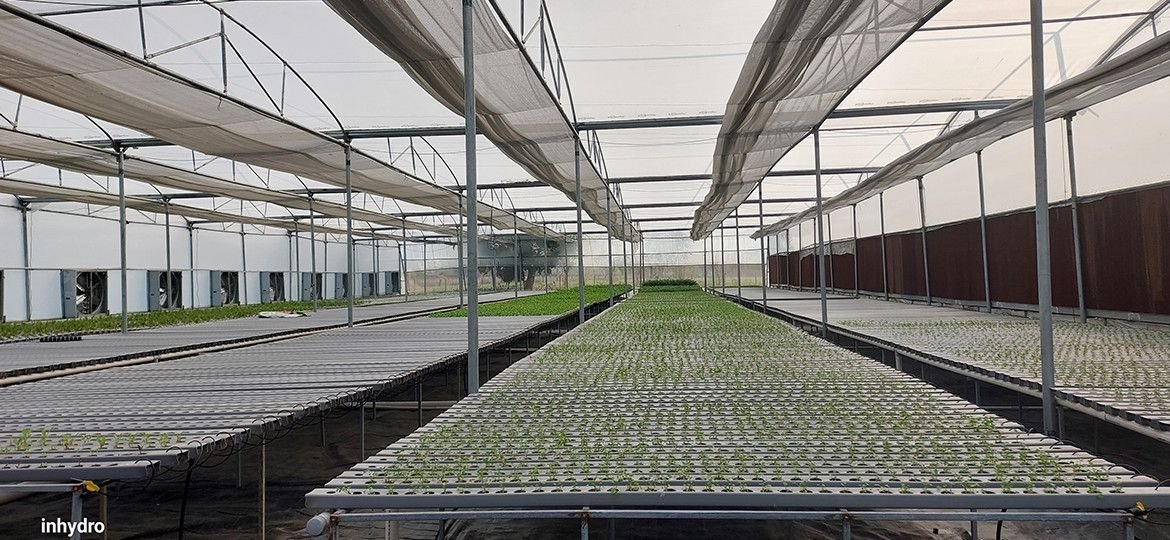
How to Start Greenhouse Farming in India
Introduction
Greenhouse farming in India is an innovative and profitable agricultural practice that enables farmers to grow crops under controlled environmental conditions. This method can significantly increase yields and allow for the production of high-quality crops year-round. Here’s a comprehensive guide to help you get started with greenhouse farming in India.
Step-by-Step Guide to Starting Greenhouse Farming
- Gain Knowledge and Training
Before starting greenhouse farming, it’s crucial to have a solid understanding of the technical, economic, and marketing aspects. Enroll in training programs or workshops on greenhouse farming to gain practical knowledge and insights.
Enroll in Inhydro’s Greenhouse Business comprehensive training and consultancy.
- Determine the Type of Greenhouse
Greenhouses can vary based on shape, construction materials, and ventilation systems. Here are some common types:
- Based on Shape:
- Sawtooth-type
- Ridge and Furrow-type
- Uneven Span
- Even Span
- Quonset
- Interlocking Ridges
- Ground-to-Ground
- Based on Construction:
- Wooden Framed Structures: Low-cost option for vegetable production.
- Pipe Framed Structures
- Based on Covering Materials:
- Glass Greenhouse: Suitable for cold climates.
- Plastic Greenhouse (Polyhouse): Predominantly used in India.
- Based on Ventilation:
- Naturally Ventilated Greenhouse: Utilizes natural ventilation to maintain temperature, humidity, and CO2 levels. Suitable for cut flowers like Gerbera, Dutch Rose, Carnation, Lily, and vegetables like Capsicum, Tomato, Cucumber, and exotic varieties.
- Climate-Controlled Greenhouse (Fan & Pad Polyhouses): Uses micro-irrigation techniques for temperature and humidity control. Ideal for high-tech nurseries and hydroponic projects.
- Select a Suitable Site
Choosing the right location for your greenhouse is critical. Consider the following factors:
- Soil Quality: pH between 5.5 to 6.5, EC (Volatility) 0.3 to 0.5 mm/cm.
- Water Quality: Continuous availability of good quality water with pH 5.5 to 7.0 and E.C. 0.1 to 0.3.
- Location: Pollution-free area with good transportation and shipping infrastructure.
- Space: Adequate for future expansion.
- Labor: Availability of workers.
- Communication: Excellent facilities.
- Drainage: Efficient soil drainage.
- Choose the Right Crops
Select crops with high commercial value and sustainable market demand. Floriculture crops and high-value vegetables are ideal for greenhouse farming.
Most Profitable Greenhouse Crops:
- Floriculture: Gerbera, Dutch Rose, Carnations, Anthurium, Lily, Orchids, Gypsophila, Limonium, Alstroemeria.
- Vegetable & Fruit: Colored Capsicum, Cucumber, Tomato, Exotic Vegetables, Strawberry.
- Create a Project Report
Prepare a comprehensive project report detailing the greenhouse farming plan. This report will be essential for securing loans and subsidies.
Steps for Creating a Project Report:
- Introduction about the Greenhouse farmer.
- Need for the Greenhouse project.
- Technical analysis.
- Economic analysis.
- Apply for Loans and Subsidies
Greenhouse farming requires significant initial investment. Many banks offer horticulture loans to support farmers.
Steps to Apply for a Loan:
- Prepare a detailed project report.
- Present the report to the bank.
- Follow the bank’s application process for loans.
Applying for Greenhouse Subsidies:
Government subsidies are available to support greenhouse farming. Check with relevant agricultural departments for detailed information and application procedures.
- Order Greenhouse Construction
Research and select a reputable greenhouse construction company. Obtain quotes and compare rates.
- Book Plants and Seedlings
Order high-quality plants and seedlings from reputable hi-tech nurseries.
- Implement Cultural Practices
Follow best practices for soil preparation, planting, irrigation, and pest control to ensure high yield and quality.
- Market Your Produce
Identify and connect with major flower agents and brokers to market your produce effectively. Developing a strong marketing strategy is essential for the success of your greenhouse farming venture.
Conclusion
By adopting greenhouse farming, Indian farmers can significantly enhance their income and contribute to the nation’s agricultural self-sufficiency. This sustainable and profitable method helps overcome traditional farming challenges, offering a promising future for the agricultural sector.
Start your journey in greenhouse farming today and become a part of India’s agricultural revolution!

